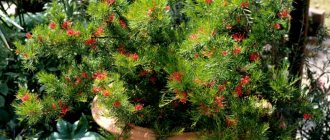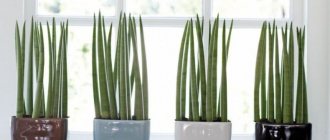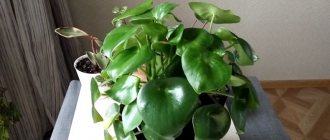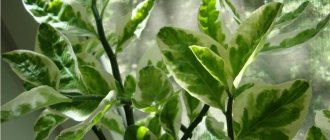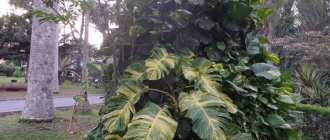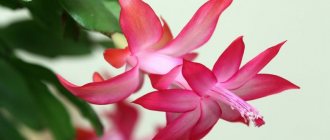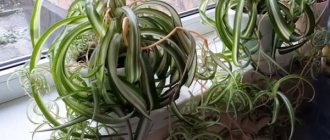At the end of the nineteenth century, for the purpose of popularization, Chlorophytum was introduced as a houseplant. These flowers gained instant demand and received a funny nickname " green spider«.
Unpretentious bushes have become a decoration for interior spaces, greenhouses, parks and balconies. Easy to care for and able to grow in pots, cache-pots, on driftwood and in rock gardens.
Nowadays, chlorophytum is still the leader among indoor plants and any gardener considers it his duty to have at least one copy of this plant in his home collection.
Short review
- Plant family: Asparagus (lat. Anthericaceae)
- Genus: Chlorophytum
- Order: Asparagus (lat. Asparagales)
- Species: Chlorophytum crested (lat. Chlorophytum comosum)
- Trivial names: green lily, family happiness
- Origin: South Africa
- perennial herbaceous plant
- Growth height: up to 60 cm
- Flowering: Possible all year round, small white flowers on long flower stems (tendrils)
- Leaves are from 20 to 45 cm long, 6 to 25 mm wide - in rosettes
Thanks to its fast and bushy growth, Chlorophytum crested has become one of the most popular indoor and office plants in the world. Its original homeland is South Africa. Chlorophytum entered European living rooms in the mid-19th century. Wild specimens with pure green leaves also grow today in various subtropical and tropical areas.
Cultivated forms of Chlorophytum crested have green leaves with a white or yellow stripe in the middle.
What does chlorophytum look like?
The herbaceous plant chlorophytum is a flower that traditionally belongs to the Liliaceae family, but some botanical catalogs include it in the Asparagales family. Long linear leaves are collected in powerful basal bunches. Small flowers bloom on very long (up to 1.5 m or more) peduncles and form a loose cluster. On the same peduncles, after the flowers fade, children are formed - bunches of leaves with aerial roots.
What does chlorophytum look like with children?For your information! The color of the leaves depends on the variety and can be uniform green or variegated with contrasting stripes.
Chlorophytum is valued as a plant that absorbs large quantities of carbon dioxide. It absorbs carbon monoxide, acetone, nicotine and formaldehyde from the air. In the kitchen, as well as smoking rooms, it is perhaps the only one capable of not only surviving, but also improving the atmosphere.
The first mention of a resident of the South African subtropics in historical chronicles was discovered in 1794. Some species are native to South America. Today, on all continents, the flower is grown in homes and offices, valued for its unpretentiousness and ability to heal the atmosphere. The name means “green plant” in Latin, which exactly matches its appearance.
Chlorophytum - benefits for the home
Due to its ease of care, Chlorophytum crested is often used as an ornamental plant in offices and residential areas.
The distinctive feature of Chlorophytum crested was discovered by American scientists in 1984. The study found that the plant can improve polluted air by filtering substances such as formaldehyde. This works especially well in enclosed spaces.
Soil and flowerpots
This is a flower that does not require any special soil. A floral, neutral soil (pH about 6-7) is suitable. It should be loose and light. If you make up an earthen substrate yourself, for chlorophytum take the following components: turf, leaf soil, humus soil and sand (2: 2: 2: 1, respectively). If there is no humus component, you can add more turf soil.
Chlorophytum crested is a tropical plant, so its roots grow a lot, so I choose wide flowerpots. You need to have good drainage at the bottom.
Chlorophytum crested: varieties
There are about 190 wild and cultivated varieties of Chlorophytum crested in the world. The most common varieties are:
Chlorophytum variegatum (lat. Chlorophytum comosum Variegatum)
- has at least one white stripe in the middle of each leaf and is the most common type of houseplant.
Chlorophytum Vittatum (lat. Chlorophytum comosum Vittatum)
- also has green-white leaves that are shorter and narrower than those of Chorophytum variegatum.
Chlorophytum Ocean (lat. Chlorophytum comosum Ocean)
- is the youngest variety and is characterized by light green leaves with a white edge.
Chlorophytum Picturatum (lat. Chlorophytum comosum Picturatum)
- produces green leaves with a yellow stripe in the middle.
Chlorophytum Bonnie (lat. Chlorophytum comosum Bonnie)
- has green-white twisted (curly) leaves.
Chlorophytum Mandainum (lat. Chlorophytum comosum Mandainum)
- has particularly short, dark green leaves with a yellow central stripe.
Chlorophytum crested (lat. Chlorophytum comosum)
- The wild form of Chlorophytum crested is characterized by purely green leaves without any patterns or stripes.
Useful properties and applications
The popularity of chlorophytum is explained not only by its unpretentiousness and visual attractiveness, but also by the benefits that this crop can bring to the owner. The fact is that this tropical culture perfectly cleans and disinfects the air, eliminating pathological microorganisms and bacteria (Figure 2).
Note: The use of chlorophytum in medicine is also explained by its ability to purify the air. On average, one bush destroys about 80% of the air. Accordingly, three or four plants will be enough to completely clean a room of 10 square meters.
Chlorophytum is often called a vacuum cleaner flower. The fact is that it not only destroys germs, but also absorbs dust from the air. In addition, the leaves of the plant accumulate moisture and gradually release it into the surrounding atmosphere, which allows you to maintain optimal humidity and microclimate in the room.
Figure 2. The culture perfectly purifies and disinfects indoor air
There are no special folk signs about growing it in an apartment, but science has proven that it is especially useful for people with weak immunity, asthma or a tendency to allergies.
Chlorophytum crested: cultivation and care
Chlorophytum crested is a very low-maintenance houseplant that survives in many situations. However, there are a few things to consider to create a healthy environment for your plants. Species-appropriate care will ensure that Chlorophytum crested will thrive and reproduce for decades.
Chlorophytum crested (lat. Chlorophytum comosum)
Location
An unpretentious plant feels comfortable in a bright place. Ideal places are where chlorophytum comes into direct contact with the sun in the morning or evening. Sunlight helps the plant develop better. However, chlorophytum should not be exposed to hot midday sun in summer.
A partially shaded location is also a good option. However, the plant grows slower in dark places and shade. Low temperatures also slow growth. Chlorophytum thrives best when the room temperature is as constant as possible, between 14°C and 18°C. It typically withstands temperatures between 10°C and 30°C.
Chlorophytum crested should be placed indoors rather than outdoors, especially during cooler months. In summer it also thrives on the balcony or garden, as long as it is not constantly exposed to direct sunlight.
Warning: Chlorophytum is a popular target for cats. They love to chew on its long leaves.
Substrate
The following is suitable as a substrate for chlorophytum:
- regular soil for flowers;
- compost-based soil mixture;
- homogeneous peat-clay soil.
The substrate should have a pH of 6 to 7, that is, it should be slightly acidic or neutral.
Transfer
Chlorophytum's dense and fast-growing root ball requires a lot of space, so the plant should be placed in a pot or hanging vase with sufficient space. Between the roots and the edge of the pot there should be an area 2 to 3 cm thick filled with soil.
As soon as roots become visible, which displace the substrate to the surface or even damage the pot, chlorophytum should be transplanted into a large container as soon as possible, regardless of the time of year.
Watering
Chlorophytum crested needs to be watered regularly with plenty of water. The soil may be constantly slightly damp, especially from spring to autumn. However, waterlogging should be avoided. Therefore, it is better to plant the plant in a pot with a drain hole. In this case, the water is removed a few minutes after watering.
The green plant can store water in its thick roots, so it can withstand short dry periods. However, such periods should not take too long and should not be repeated too often. You can quickly see from dry leaf tips, pest infestations and light, wilted leaves that Chlorophytum is not getting enough water.
Brown leaf tips may also indicate that indoor humidity is too low. It should be between 50% and 70%. If the air humidity is too low, it is necessary to regularly spray the plant with water.
Fertilizer
Caring for chlorophytum also includes supplying the plant with nutrients. Targeted fertilizer stimulates overall plant growth, resulting in the formation of new leaves and numerous shoots. However, the overall nutrient requirement of chlorophytum is quite low.
During the main growing season, which runs from March to September, it is recommended to add a little liquid fertilizer to the soil every two to four weeks. Basic soil fertilization should be from 1 to 1.5 kg per cubic meter. A balanced complex fertilizer is used.
The exact amount of fertilizer depends on the nutrient content of the substrate. For example, if chlorophytum is replanted every year, then no fertilizer is required.
Wintering
At room temperature, Chlorophytum crested thrives year-round. In winter, however, it is necessary to give the plant a rest and not fertilize it. If chlorophytum is located in a cool place, you should make sure that the air temperature is at least 10 °C. At these low temperatures, it needs less water than during the main growing season. In this case, the plant should be watered when the surface of the earth dries out a little.
Caring for chlorophytum flowers at home
Both types of chlorophytum are generally unpretentious, but their natural habitats - tropical forests - leave their mark on care. For example, in winter it is better to keep them at a temperature no higher than 18 °C. But there are other features of agricultural technology.
Priming
Chlorophytums love light soil rich in organic matter. The ideal composition is turf soil, leaf soil, humus and sand in a ratio of 2:1:1:1.
You can also grow chlorophytums in purchased soil - soil for decorative foliage plants is suitable.
Lighting
Chlorophytums in nature often grow in the crowns of trees, and there is always diffused light. This must be taken into account at home too. Open sun is contraindicated for them, that is, they cannot be placed on a south window - under the scorching rays their leaves turn pale and wither. It is best to grow them on an east or west window, but, again, the plants should not be exposed to direct rays - it is better to hide the chlorophytums behind larger flowers.
You can place chlorophytum on a north window and even deep into the room, but in this case the color of the leaves will be dull.
Humidity
Tropical forests are also called rain forests. It is very damp there, there is often fog, therefore, chlorophytum needs high air humidity, at least 80%. But in our apartments with central heating it does not exceed 25%. This is very little, so chlorophytums need to be sprayed frequently, or place bowls of water next to them - as it evaporates, it will moisten the air around the plant.
In the warm season, it is advisable to water chlorophytums 2 times a week, in winter - 1 time a week. However, these plants can withstand drought for quite a long time, but at the same time they lose their decorative properties. So it's better not to experiment. However, you shouldn’t water them too much either - the roots of chlorophytums are prone to rotting.
Fertilizers
If you prepare the soil yourself, you do not need to add fertilizers to it - there is enough organic matter there.
But it is useful to add humus to the purchased soil - 1/4 of the volume of soil.
Feeding
In nature, chlorophytums grow in the forks of trees, where leaves accumulate and rot. Therefore, it is best to feed them with organic matter - any liquid complex organic fertilizer for decorative deciduous plants will do.
Feeding should be given during the period of active growth - from the beginning of March to the end of October, once every 2 weeks.
Photo: globallookpress.com
Chlorophytum crested: reproduction
With proper care, Chlorophytum crested is very prolific and multiplies quickly. This is done using the following methods:
Children
Since chlorophytum produces many children, propagating it in this way is the fastest option. Small daughter plants emerge from the flowers after they wither. The flowers grow in small bunches on pendulous flower stems up to 75 cm long, so multiple shoots can develop from each stem.
Young children form roots in the air and pull the stems with their weight towards the ground.
The baby can be separated from the mother plant once it has at least five leaves about five centimeters long. If the baby already has roots at least three centimeters long, the young plant can be immediately planted in a separate pot. The baby grows quickly at room temperature around 20 °C.
If the roots are shorter, place the separated baby in water first. In addition, the stem of the mother plant on which the baby grows can be placed in a pot of soil without separation. Once the daughter plant has taken root after a few weeks, the stem is cut off. The more often the children are separated from the mother plant, the more the growth of new flower stems is stimulated.
Chlorophytum crested (lat. Chlorophytum comosum)
Seeds
The wild form and several cultivated varieties of Chlorophytum crested form small capsule fruits in which three seeds ripen. If the capsule bursts, black seeds fall to the ground. Such propagation occurs mainly during professional plant selection and less often in private farms.
Dividing the plant
Chlorophytum crested can be propagated by dividing the plant into two or more parts. This method is especially suitable if the mother plant has become too large.
Types of chlorophytum with photos
Chlorophytum capense
This herbaceous perennial rosette plant has roots similar to tubers. The shape of the smooth pale green leaf plates is lanceolate, they taper towards the base and apex, there is a groove on the front surface of the leaf, and a keel on the back surface. The width of the leaves is about 3 centimeters, and their length is up to 50 centimeters. During flowering, a peduncle appears from the rosette. White small flowers are collected in racemes; they grow from the axils of the leaves located on the peduncle. The fruit is a capsule. In this species, the formation of young leaf rosettes is not observed on the peduncles.
Winged chlorophytum (Chlorophytum amaniense)
The dark green leaf blades have long petioles that range in color from pink to reddish-orange. The grooved foliage tapers at the top and base (near the petiole). Varieties such as Fire Flash and Green Orange have petioles of an unusual orange color. To prevent the petioles from losing their rich color, the flower stalks should be cut off in a timely manner.
Chlorophytum comosum
This is also a herbaceous perennial plant with a very short stem. Pale green smooth leaf blades grow from the stem, they have an elongated lanceolate shape and at the same time they bend effectively. A shoot appears from the middle of the rosette, and small white star-shaped flowers grow on it. When flowering comes to an end, young leaf rosettes grow from the axils of the leaves of this shoot. The white roots are very dense and juicy.
Chlorophytum crested / Caring for chlorophytum at home
Chlorophytum crested: diseases and pests
Because Chlorophytum crested is hardy and easy to care for, diseases are rare. Dried leaves often indicate waterlogging, which should be corrected as soon as possible by draining excess water. If waterlogging continues, the plant can become infected with bacteria that can cause severe bacterial wet rot. These bacteria spread quickly and are difficult to control. Therefore, throw away affected plants and protect healthy specimens from contact with them.
Aphid
When infested by aphids, chlorophytum exhibits the following symptoms:
- there are a lot of small aphids on the underside of the leaves;
- leaves curl strongly;
- bubbles form on the surface of the leaf;
- the plant becomes sticky;
- the children are fading.
To remove aphids, chlorophytum is thoroughly sprayed on all sides with a mixture of water and detergent. Repeat the process every two to three days until the aphids are gone. You can also use insecticides.
Mealybugs
Mealybugs can also harm chlorophytum. Their white bodies are easy to see against the green leaves. Infection is also indicated by the fact that the leaves change color and shrink. The scale insects secrete honeydew, which collects on the plant.
To prevent chlorophytum from dying, the plant should be quickly treated with a pest control agent. After about two weeks, the appropriate insecticide must be used again as it does not work against insect eggs.
As soon as you discover an infestation, isolate the affected plant. This will prevent further spread of pests.
Whiteflies
Whiteflies can be controlled using insecticides or a yellow sticky sticker. Signs of chlorophytum infection by these pests:
- if you move a plant, insects fly up;
- the leaves first turn yellow, then become spotted;
- subsequently the leaves dry out and then fall off;
- Honeydew collects on the upper side of the leaf.
Spider mites
Small pests are found especially in winter. They can be seen due to small light dots on the leaves. If infested for a long time, the leaves slowly turn brown and dry out. Place the affected plant in the shower and rinse thoroughly. Then cover it completely with a plastic bag, close it tightly and place the plant in place.
The humidity inside the bag will increase. The package must be left on the plant for at least two weeks. This leads to the death of spider mites. If this method is not sufficient to completely control the mites, the plant can be sprayed carefully with insecticides.
Cats
Chlorophytum crested magically attracts cats. Pets are not pests in the classic sense, but they do enjoy chewing on the long leaves. Bite marks look very unsightly. Eating chlorophytum can also be harmful to cats because the plant absorbs pollutants from the air and fertilizers accumulate in the leaves.
Growing problems
Chlorophytum crested is resistant to diseases, but occasionally suffers from root rot - when liquid stagnates in the soil. The leaves will tell you that the plant is flooded: they will turn yellow. Also, with excessive watering, gardeners often observe black spots on the leaf blades, and with insufficient watering, dry tips. Another reason for yellowness is excess sunlight.
Dry air and insufficient watering are favorable conditions for the proliferation of spider mites. The mealybug migrates from other plants to the chlorophytum, and another flower lover is the aphid. To get rid of parasites, wipe the leaves with soapy water or use special insecticides.
Signs and superstitions
Superstitions and omens say about chlorophytum that this flower brings only positive energy to others. A plant in the house lifts the mood of those around you and relieves irritability. Because of this, quarrels in the family stop. For new residents, the flower will help them quickly settle into their new home and create a comfortable atmosphere and coziness in it.
Our great-grandmothers believed that with the help of a lush ampelous plant, spouses could regain interest in each other, and lonely hearts would find their happiness.
Proper care of indoor chlorophytum at home is a guarantee that your Green Corner will be decorated with a useful plant with beautiful leaves.
Description of the plant
The herbaceous perennial produces thick tuberous root shoots of yellow or brown color. The powerful root system accumulates a large amount of moisture from the soil and is able to nourish the crop without watering for a long time. A short stem grows from the root rosette, on which a large number of narrow, pointed leaves 1.5-2 cm wide are formed. The full life cycle of chlorophytum is 10 years. Periodically, dense flexible tendrils grow from the stem, on which miniature bushes with leaves and aerial roots appear. The representative of the flora blooms in spring and autumn with small white or light green flowers on long shoots. In place of faded elements, seed pods are formed.
